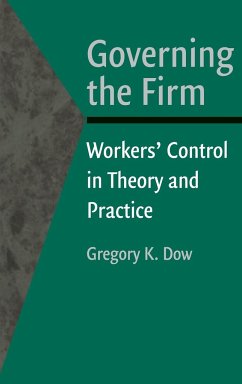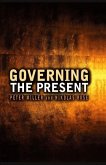Gregory K. Dow
Governing the Firm
Gregory K. Dow
Governing the Firm
- Gebundenes Buch
- Merkliste
- Auf die Merkliste
- Bewerten Bewerten
- Teilen
- Produkt teilen
- Produkterinnerung
- Produkterinnerung
This book provides case studies of worker-controlled firms and surveys available evidence on their behavior.
Andere Kunden interessierten sich auch für
![Governing Modalities of the Extractive Industry in Iraq Governing Modalities of the Extractive Industry in Iraq]() Ahmed Mousa JiyadGoverning Modalities of the Extractive Industry in Iraq50,99 €
Ahmed Mousa JiyadGoverning Modalities of the Extractive Industry in Iraq50,99 €![Social Norms and the Theory of the Firm Social Norms and the Theory of the Firm]() Douglas E StevensSocial Norms and the Theory of the Firm85,99 €
Douglas E StevensSocial Norms and the Theory of the Firm85,99 €![The Cooperative Nature of the Firm The Cooperative Nature of the Firm]() Tatsuro IchiishiThe Cooperative Nature of the Firm65,99 €
Tatsuro IchiishiThe Cooperative Nature of the Firm65,99 €![The driving forces and innovation process of Swedish eco-innovation and food-tech firm The driving forces and innovation process of Swedish eco-innovation and food-tech firm]() Nicole SkoglundThe driving forces and innovation process of Swedish eco-innovation and food-tech firm17,95 €
Nicole SkoglundThe driving forces and innovation process of Swedish eco-innovation and food-tech firm17,95 €![Statutes And Regulations Governing Entries And Proof Under The Desert Land Laws, Together With Suggestions To Person Desiring To Make Entries Under Sa Statutes And Regulations Governing Entries And Proof Under The Desert Land Laws, Together With Suggestions To Person Desiring To Make Entries Under Sa]() Statutes And Regulations Governing Entries And Proof Under The Desert Land Laws, Together With Suggestions To Person Desiring To Make Entries Under Sa27,99 €
Statutes And Regulations Governing Entries And Proof Under The Desert Land Laws, Together With Suggestions To Person Desiring To Make Entries Under Sa27,99 €![Michael Oakeshott on Authority, Governance, and the State Michael Oakeshott on Authority, Governance, and the State]() Michael Oakeshott on Authority, Governance, and the State90,99 €
Michael Oakeshott on Authority, Governance, and the State90,99 €![Governing the Present Governing the Present]() Nikolas RoseGoverning the Present70,99 €
Nikolas RoseGoverning the Present70,99 €-
-
-
This book provides case studies of worker-controlled firms and surveys available evidence on their behavior.
Produktdetails
- Produktdetails
- Verlag: Cambridge University Press
- Seitenzahl: 342
- Erscheinungstermin: 6. Februar 2018
- Englisch
- Abmessung: 235mm x 157mm x 23mm
- Gewicht: 647g
- ISBN-13: 9780521818537
- ISBN-10: 0521818532
- Artikelnr.: 29337979
- Herstellerkennzeichnung
- Libri GmbH
- Europaallee 1
- 36244 Bad Hersfeld
- gpsr@libri.de
- Verlag: Cambridge University Press
- Seitenzahl: 342
- Erscheinungstermin: 6. Februar 2018
- Englisch
- Abmessung: 235mm x 157mm x 23mm
- Gewicht: 647g
- ISBN-13: 9780521818537
- ISBN-10: 0521818532
- Artikelnr.: 29337979
- Herstellerkennzeichnung
- Libri GmbH
- Europaallee 1
- 36244 Bad Hersfeld
- gpsr@libri.de
1. Introduction: 1.1 Economic systems
1.2 The control dimension
1.3 Looking for clues
1.4 A projected synthesis
1.5 The plan of the book
2. Normative perspectives: 2.1 Why care about workers' control?
2.2 Equality
2.3 Democracy
2.4 Property
2.5 Dignity
2.6 Community
2.7 The author shows his cards
3. Workers' control in action (I): 3.1 Surveying the terrain
3.2 The Plywood cooperatives
3.3 The Mondragon cooperatives
4. Workers' control in action (II): 4.1 The Lega cooperatives
4.2 Employee stock ownership plans
4.3 Codetermination
5. Conceptual foundations: 5.1 The theory of the firm
5.2 The nature of authority
5.3 The locus of control
5.4 Why firms cannot be owned
5.5 Asset ownership
5.6 Residual claims
6. Explanatory strategies: 6.1 The symmetry principle
6.2 The replication principle
6.3 Transaction costs
6.4 Optimal contracting
6.5 Adverse selection
6.6 Repeated games
6.7 Path dependence
6.8 Cultural explanations
6.9 The strategy to be pursued
7. A question of objectives: 7.1 What do labor-managed firms maximize?
7.2 The Illyrian firm
7.3 Membership markets and labor markets
7.4 Membership markets and stock markets
7.5 Imperfect membership markets
7.6 What does the evidence say?
7.7 Some lessons
8. Views from economic theory I: 8.1 Explaining the rarity of workers' control
8.2 Asset ownership: incentives and information
8.3 Asset ownership: bargaining and information
8.4 Can asset specificity explain the rarity of workers' control?
8.5 Work incentives without risk aversion
8.6 Work incentives with risk aversion
8.7 Can work incentives explain the rarity of workers' control?
9. Views from economic theory (II): 9.1 Capital constraints
9.2 Debt financing
9.3 Equity financing
9.4 Can capital constraints explain the rarity of workers' control?
9.5 Portfolio diversification
9.6 Can portfolio diversification explain the rarity of workers' control?
9.7 Collective choice
9.8 Can collective choice explain the rarity of workers' control?
10. Transitions and clusters: 10.1 Organizational demography
10.2 Formation rates
10.3 Worker takeovers
10.4 Degeneration
10.5 Investor takeovers
10.6 Survival rates
10.7 Business cycles
10.8 Clusters
11. Toward a synthesis: 11.1 The causal tapestry
11.2 Credible commitment toward labor
11.3 Credible commitment toward capital
11.4 The composition of control groups
11.5 The commodification of control rights
11.6 Intellectual history and current debates
11.7 Is workers' control a unitary phenomenon?
12. Getting there from here: 12.1 Practical considerations
12.2 A modest proposal
12.3 Reassuring shareholders
12.4 Governing firms
12.5 Trading jobs
12.6 Sample calculations
12.7 The long and winding road.
1.2 The control dimension
1.3 Looking for clues
1.4 A projected synthesis
1.5 The plan of the book
2. Normative perspectives: 2.1 Why care about workers' control?
2.2 Equality
2.3 Democracy
2.4 Property
2.5 Dignity
2.6 Community
2.7 The author shows his cards
3. Workers' control in action (I): 3.1 Surveying the terrain
3.2 The Plywood cooperatives
3.3 The Mondragon cooperatives
4. Workers' control in action (II): 4.1 The Lega cooperatives
4.2 Employee stock ownership plans
4.3 Codetermination
5. Conceptual foundations: 5.1 The theory of the firm
5.2 The nature of authority
5.3 The locus of control
5.4 Why firms cannot be owned
5.5 Asset ownership
5.6 Residual claims
6. Explanatory strategies: 6.1 The symmetry principle
6.2 The replication principle
6.3 Transaction costs
6.4 Optimal contracting
6.5 Adverse selection
6.6 Repeated games
6.7 Path dependence
6.8 Cultural explanations
6.9 The strategy to be pursued
7. A question of objectives: 7.1 What do labor-managed firms maximize?
7.2 The Illyrian firm
7.3 Membership markets and labor markets
7.4 Membership markets and stock markets
7.5 Imperfect membership markets
7.6 What does the evidence say?
7.7 Some lessons
8. Views from economic theory I: 8.1 Explaining the rarity of workers' control
8.2 Asset ownership: incentives and information
8.3 Asset ownership: bargaining and information
8.4 Can asset specificity explain the rarity of workers' control?
8.5 Work incentives without risk aversion
8.6 Work incentives with risk aversion
8.7 Can work incentives explain the rarity of workers' control?
9. Views from economic theory (II): 9.1 Capital constraints
9.2 Debt financing
9.3 Equity financing
9.4 Can capital constraints explain the rarity of workers' control?
9.5 Portfolio diversification
9.6 Can portfolio diversification explain the rarity of workers' control?
9.7 Collective choice
9.8 Can collective choice explain the rarity of workers' control?
10. Transitions and clusters: 10.1 Organizational demography
10.2 Formation rates
10.3 Worker takeovers
10.4 Degeneration
10.5 Investor takeovers
10.6 Survival rates
10.7 Business cycles
10.8 Clusters
11. Toward a synthesis: 11.1 The causal tapestry
11.2 Credible commitment toward labor
11.3 Credible commitment toward capital
11.4 The composition of control groups
11.5 The commodification of control rights
11.6 Intellectual history and current debates
11.7 Is workers' control a unitary phenomenon?
12. Getting there from here: 12.1 Practical considerations
12.2 A modest proposal
12.3 Reassuring shareholders
12.4 Governing firms
12.5 Trading jobs
12.6 Sample calculations
12.7 The long and winding road.
1. Introduction: 1.1 Economic systems
1.2 The control dimension
1.3 Looking for clues
1.4 A projected synthesis
1.5 The plan of the book
2. Normative perspectives: 2.1 Why care about workers' control?
2.2 Equality
2.3 Democracy
2.4 Property
2.5 Dignity
2.6 Community
2.7 The author shows his cards
3. Workers' control in action (I): 3.1 Surveying the terrain
3.2 The Plywood cooperatives
3.3 The Mondragon cooperatives
4. Workers' control in action (II): 4.1 The Lega cooperatives
4.2 Employee stock ownership plans
4.3 Codetermination
5. Conceptual foundations: 5.1 The theory of the firm
5.2 The nature of authority
5.3 The locus of control
5.4 Why firms cannot be owned
5.5 Asset ownership
5.6 Residual claims
6. Explanatory strategies: 6.1 The symmetry principle
6.2 The replication principle
6.3 Transaction costs
6.4 Optimal contracting
6.5 Adverse selection
6.6 Repeated games
6.7 Path dependence
6.8 Cultural explanations
6.9 The strategy to be pursued
7. A question of objectives: 7.1 What do labor-managed firms maximize?
7.2 The Illyrian firm
7.3 Membership markets and labor markets
7.4 Membership markets and stock markets
7.5 Imperfect membership markets
7.6 What does the evidence say?
7.7 Some lessons
8. Views from economic theory I: 8.1 Explaining the rarity of workers' control
8.2 Asset ownership: incentives and information
8.3 Asset ownership: bargaining and information
8.4 Can asset specificity explain the rarity of workers' control?
8.5 Work incentives without risk aversion
8.6 Work incentives with risk aversion
8.7 Can work incentives explain the rarity of workers' control?
9. Views from economic theory (II): 9.1 Capital constraints
9.2 Debt financing
9.3 Equity financing
9.4 Can capital constraints explain the rarity of workers' control?
9.5 Portfolio diversification
9.6 Can portfolio diversification explain the rarity of workers' control?
9.7 Collective choice
9.8 Can collective choice explain the rarity of workers' control?
10. Transitions and clusters: 10.1 Organizational demography
10.2 Formation rates
10.3 Worker takeovers
10.4 Degeneration
10.5 Investor takeovers
10.6 Survival rates
10.7 Business cycles
10.8 Clusters
11. Toward a synthesis: 11.1 The causal tapestry
11.2 Credible commitment toward labor
11.3 Credible commitment toward capital
11.4 The composition of control groups
11.5 The commodification of control rights
11.6 Intellectual history and current debates
11.7 Is workers' control a unitary phenomenon?
12. Getting there from here: 12.1 Practical considerations
12.2 A modest proposal
12.3 Reassuring shareholders
12.4 Governing firms
12.5 Trading jobs
12.6 Sample calculations
12.7 The long and winding road.
1.2 The control dimension
1.3 Looking for clues
1.4 A projected synthesis
1.5 The plan of the book
2. Normative perspectives: 2.1 Why care about workers' control?
2.2 Equality
2.3 Democracy
2.4 Property
2.5 Dignity
2.6 Community
2.7 The author shows his cards
3. Workers' control in action (I): 3.1 Surveying the terrain
3.2 The Plywood cooperatives
3.3 The Mondragon cooperatives
4. Workers' control in action (II): 4.1 The Lega cooperatives
4.2 Employee stock ownership plans
4.3 Codetermination
5. Conceptual foundations: 5.1 The theory of the firm
5.2 The nature of authority
5.3 The locus of control
5.4 Why firms cannot be owned
5.5 Asset ownership
5.6 Residual claims
6. Explanatory strategies: 6.1 The symmetry principle
6.2 The replication principle
6.3 Transaction costs
6.4 Optimal contracting
6.5 Adverse selection
6.6 Repeated games
6.7 Path dependence
6.8 Cultural explanations
6.9 The strategy to be pursued
7. A question of objectives: 7.1 What do labor-managed firms maximize?
7.2 The Illyrian firm
7.3 Membership markets and labor markets
7.4 Membership markets and stock markets
7.5 Imperfect membership markets
7.6 What does the evidence say?
7.7 Some lessons
8. Views from economic theory I: 8.1 Explaining the rarity of workers' control
8.2 Asset ownership: incentives and information
8.3 Asset ownership: bargaining and information
8.4 Can asset specificity explain the rarity of workers' control?
8.5 Work incentives without risk aversion
8.6 Work incentives with risk aversion
8.7 Can work incentives explain the rarity of workers' control?
9. Views from economic theory (II): 9.1 Capital constraints
9.2 Debt financing
9.3 Equity financing
9.4 Can capital constraints explain the rarity of workers' control?
9.5 Portfolio diversification
9.6 Can portfolio diversification explain the rarity of workers' control?
9.7 Collective choice
9.8 Can collective choice explain the rarity of workers' control?
10. Transitions and clusters: 10.1 Organizational demography
10.2 Formation rates
10.3 Worker takeovers
10.4 Degeneration
10.5 Investor takeovers
10.6 Survival rates
10.7 Business cycles
10.8 Clusters
11. Toward a synthesis: 11.1 The causal tapestry
11.2 Credible commitment toward labor
11.3 Credible commitment toward capital
11.4 The composition of control groups
11.5 The commodification of control rights
11.6 Intellectual history and current debates
11.7 Is workers' control a unitary phenomenon?
12. Getting there from here: 12.1 Practical considerations
12.2 A modest proposal
12.3 Reassuring shareholders
12.4 Governing firms
12.5 Trading jobs
12.6 Sample calculations
12.7 The long and winding road.








